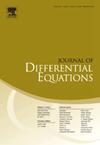Symplectic normal form and growth of Sobolev norm
IF 2.3
2区 数学
Q1 MATHEMATICS
引用次数: 0
Abstract
For a class of reducible Hamiltonian partial differential equations (PDEs) with arbitrary spatial dimension, quantified by a quadratic polynomial with time-dependent coefficients, we present a comprehensive classification of long-term solution behaviors within Sobolev space. This classification is achieved through the utilization of Metaplectic and Schrödinger representations. Each pattern of Sobolev norm behavior corresponds to a specific n−dimensional symplectic normal form, as detailed in Theorems 1.1 and 1.2.
When applied to periodically or quasi-periodically forced n−dimensional quantum harmonic oscillators, we identify novel growth rates for the norm as t tends to infinity, such as (with ) and (with ). Notably, we demonstrate that stability in Sobolev space, defined as the boundedness of the Sobolev norm, is essentially a unique characteristic of one-dimensional scenarios, as outlined in Theorem 1.3.
As a byproduct, we discover that the growth rate of the Sobolev norm for the quantum Hamiltonian can be directly described by that of the solution to the classical Hamiltonian which exhibits the optimal growth, as articulated in Theorem 1.4.
Sobolev范数的辛范式和增长
对于一类具有任意空间维数的可约哈密顿偏微分方程(PDEs),我们给出了Sobolev空间内长期解行为的综合分类。这种分类是通过使用Metaplectic和Schrödinger表示来实现的。Sobolev范数行为的每个模式对应于特定的n维辛范式,如定理1.1和1.2中详细介绍的那样。当应用于周期或准周期强制n维量子谐振子时,我们确定了当t趋于无穷时Hs -范数的新增长率,例如t(n−1)seλst (λ>0)和t(2n−1)s+ιt2ns (ι≥0)。值得注意的是,我们证明了Sobolev空间中的稳定性,定义为Sobolev范数的有界性,本质上是一维场景的独特特征,如定理1.3所述。作为一个副产品,我们发现量子哈密顿量的Sobolev范数的增长率可以直接用经典哈密顿量的解的增长率来描述,经典哈密顿量表现出最优的增长,如定理1.4所述。
本文章由计算机程序翻译,如有差异,请以英文原文为准。
求助全文
约1分钟内获得全文
求助全文
来源期刊
CiteScore
4.40
自引率
8.30%
发文量
543
审稿时长
9 months
期刊介绍:
The Journal of Differential Equations is concerned with the theory and the application of differential equations. The articles published are addressed not only to mathematicians but also to those engineers, physicists, and other scientists for whom differential equations are valuable research tools.
Research Areas Include:
• Mathematical control theory
• Ordinary differential equations
• Partial differential equations
• Stochastic differential equations
• Topological dynamics
• Related topics

 求助内容:
求助内容: 应助结果提醒方式:
应助结果提醒方式:


